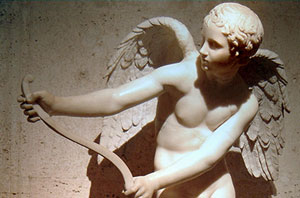
Source: Cupid, Ricardo André Frantz, Wikipedia
To better tell a story or emphasize a point, authors sometimes use allusions that involve references to myths, classical, or traditional texts. Mythology, classic literature, and traditional literature are all types of literary genres. Allusions are an important part of understanding literature because they give us a deeper understanding of an author’s message. An author can skillfully draw upon allusions to give a story, poem, play, or other literary form more meaning or to provide clues about an author’s message.
The individual sections of this lesson will focus on understanding what allusion is, its importance and use as a literary device, and how to recognize it in reading. The main thing to know as you begin this lesson is that allusion can be used to add meaning to what you read.
You’re probably familiar with Greek and Roman myths. The Greeks and Romans had many gods and goddesses in common, but the Roman name often differed from the Greek name. Gods and goddesses from Roman and Greek mythology are often alluded to in other pieces of literature. For this reason, it’s nice to know about Roman and Greek mythology as you read more difficult texts in high school.
Shakespeare’s play Romeo and Juliet, for example, is chock full of allusions to gods and goddesses. For example, in Act I, Scene 4, Mercutio tells Romeo to “Take Cupid’s wings and fly higher than the average man.” And Romeo responds with “His (meaning Cupid’s) arrow has pierced me too deeply, so I can’t fly high with his cheerful feathers.” In Roman mythology, Cupid is the god of desire, affection, and love. Even though Mercutio has encouraged Romeo to dance like a man in love—like the winged Cupid—Romeo responds that he can't because he’s so much in love that it's weighing him down and making him unhappy.
Let’s do a quick review of Roman and Greek mythology. For each god or goddess that appears below, choose the correct name from the drop-down menu. If you answer correctly, you will see “Correct!” If you answer incorrectly, please try again. Good luck!
Source: Roman and Greek Dieties, Wikimedia Commons